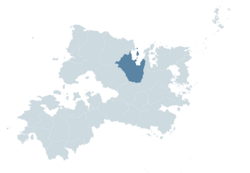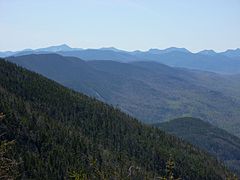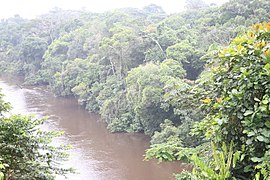Ogonkai: Difference between revisions
mNo edit summary Tag: 2017 source edit |
mNo edit summary Tag: 2017 source edit |
||
| Line 24: | Line 24: | ||
|alt_map2 = <!--alt text for second map--> | |alt_map2 = <!--alt text for second map--> | ||
|map_caption2 = <!--Caption to place below second map--> | |map_caption2 = <!--Caption to place below second map--> | ||
|capital = None<ref>While | |capital = None (de jure)<br> Kinhara (de facto)<ref>While the current Charter establishes that there is no capital city, both the National Council and Supreme Tribunal are headquartered in Kinhara.</ref> | ||
|largest_city = Minakyo | |largest_city = Minakyo | ||
|official_languages = Ogonkaic<br> | |official_languages = Ogonkaic<br> | ||
Revision as of 00:49, 16 October 2024
Council of Ogonkai 黄金海参事会 (Ogonkai-sanjikai) | |
|---|---|
Motto: 一致団結 ("Solidarity") | |
Anthem: 十二黄金海波 ("Twelve golden waves") | |
 Location of Ogonkai (dark blue) In Audonia (light blue) | |
| Capital | None (de jure) Kinhara (de facto)[1] |
| Largest city | Minakyo |
| Official languages | Ogonkaic |
| Ethnic groups | Ogonkaic, Daxian |
| Religion | Golden god worship |
| Demonym(s) | Ogonkan, Ogonkaic |
| Government | Federal directorial republic |
• Representative of Iwanobe District | Kouno Kagetori |
• Representative of Fujisato District | Hori Hidetaka |
• Representative of Shimakoshi District | Inagaki Katsunaga |
• Representative of Tawazaki District | Aso Tadamasa |
• Representative of Iwanobe District | Wada Koreyori |
• Representative of Narazaki District | Sukeko Morikawa |
• Representative of Ryokuya District | Sugawara Suekata |
• Representative of Kaibe District | Matsura Yokitoshi |
• Representative of Mannaka District | Osa Ishimaki |
• Representative of Iwanobe District | Suko Kanamaru |
• Representative of Hakusan District | Urakami Ietada |
| Establishment | |
• As the Golden Sea States | 991-1581 |
• As the Council of Ogonkai | 17 November 1690 |
• Current Charter | 1 December 1974 |
| Area | |
• Total | 1,303,126.62 km2 (503,140.00 sq mi) |
| Population | |
• Estimate | 24,849,014 |
| GDP (nominal) | estimate |
• Total | Your GDP = GDPPC x Population (This is calculated for you after first entry) |
• Per capita | Your GDP PC |
| Gini | Your gini coefficient Error: Invalid Gini value |
| Currency | Chyo (Ȼ) |
| Driving side | right |
Ogonkai, officially the Council of Ogonkai or the Ogonkaic Council, is a country in northern Audonia. To the west and south, it is bordered by Jazee, Kandara and Ankivara. To the east, it is bordered by Wonjin and Ugioh. It comprises an area of 1,303,126km2 (503,104 sq mi) spread among its main continental landmass with hundreds of islands. Ogonkai has a population of 24 million, standing among the least populated nations in the continent. While lacking a federal capital, the National Council meets in the historic city of Kinhara. Minakyo is Ogonkai's most populated city with an estimated population of three million. Other major hubs include Aoyama, Kinhara, Yamatake and Sugihara. Divided among 11 districts and 3 special territories, roughly half of the nation's territory is extremely mountainous, concentrating its highly urbanized population and robust industry to its coastal areas and major islands.
While the territory that now comprises Ogonkai has historically been sparsely settled with major population centers instead concentrating south in Daxia and its neighboring territories, the first of many migrations towards the territory commenced roughly 13,000 years ago, with evidence of the first human habitation dating back to 20,000 years ago. After these migrations, widespread habitation of the territory began. Centuries later, as a way to defend against the increasingly more common Myanga Ayil Khanate incursions throughout the region, the villages and small fiefdoms that dotted the territory began crystallizing into their own, independent kingdoms in the late tenth century.
Following a brief period of unified control from the city of Kinhara, the eleven kingdoms returned to being separate entities ruled by their own local lords until first contact with the Carto-Pelaxian Commonwealth forced the kingdoms into trading and unifying with one another. The Charter of Unity was signed by the lords of the eleven realms in 1690 and was followed by an economic and population boom, consolidation of the newly-established upper class, forming of a cohesive national identity, and voluminous trade with both the Commonwealth and emerging Tierradorian trading companies.
After the dissolution of the Commonwealth, Ogonkai instaurated a policy of national isolation, termed "heiwakoku", avoiding the conflicts that rocked the world at the time that lasted up to the start of the First Great War. The end of the period of isolation was followed by rapid modernization and staunch neutrality in the First and Second great wars. The rapid post-war economic boom precipitated a series of controversial anti-monarchic revolts that in 1974 culminated in the Itchou Revolutions, resulting in the replacement of the Charter of Unity with the current Chart of Solidarity that has remained in effect ever since.
Presently, Ogonkai is a federal directorial republic, in which the power to create laws and administrate the country is jointly exercised by the representatives of the eleven districts (collectively the National Council). While Ogonkai boasts high standards of living and a vibrant economy, the nation struggles with high rates of inequality, discrimination (especially towards its non-ethnic Ogonkaic citizens), an stagnated political atmosphere and corruption. Internationally, Ogonkai is renowned for its global cultural footprint; Ogonkai's globally influential culture is present in its pervasive animation, art, music and videogame industries, as well as an emerging robotics industry.
Etymology
The name for Ogonkai in the Ogonkaic language is written using the characters 黄金海. the characters "黄金", read "ogon", refer to gold, while the character "海", read "kai" refers to sea. Thus, the meaning of Ogonkai is "Golden Sea"; this is the source of the epithet "Land of the Golden Sea". Current consensus among historians establishes that this name was adopted during the brief spell of unification of the eleven kingdoms under the city of Kinhara, as the city shares the same characters (黄金)
Throughout the 17th century, the reading "Koganemi" was also used, but fell into disuse after the first contact with the Carto-Pelaxian Commonwealth; the explorers that came on the ships arrived at the sunset, and thus they called the land as "Tierra del Mar Dorado" or "Terra do Mar Dorado".
Following contact with the Commonwealth, several newly-formed companies hailing from Tierrador established contact with the native population as well; in what is believed to be a mistranslation, the Tierradorian explorers mistakenly believed the name of the population to be "the Ogonkai", so they used the name "Apin Ogúúset" ("Far-away Ogonkan") to refer to its inhabitants.
History
What is a general overview of your country's path through history?
First migrations and mass settlement (11,000 BCE - 991 CE)
Formation of the eleven kingdoms (991 - 1581)
What were the first political structures of your country? Did it have any very early rivals or was it controlled by a foreign country?
Kinhara-led unification of the eleven kingdoms (1611 - 1632)
What were your country's first major moves on an international level?
Collapse of Greater Kinhara and last years of the kingdoms (1632 - 1690)
Did your country ever have a period of significant decline or internal struggle?
Contact with the Commonwealth and unification (1690 - 1795)
Was your country subject to imperialism later in its life, or was it an imperial power?
"Heiwakoku" period (1796 - 1896)
How did the 20th century affect your country?
End of Heiwakoku and role in the Great Wars (1896 - 1943)
Itchou Revolutions and present day (1974-)
Geography
-
First lovely location
-
Second lovely location
-
Third lovely location
-
Fourth lovely location
-
Fifth lovely location
-
Sixth lovely location
What is the general explanation of how your country exists within the world?
Climate and environment
Is your country hot or cold?
Government and Politics
How is your country ruled or governed?
Executive
Who is responsible for making high level choices in your country? Does it have a President or King?
Legislative
Who decides the laws for your country? Is there political parties and a legislature?
Federal subdivisions
How is your country divided? Are there states or provinces, or is the country directly governed from the capital as a unitary state?
Politics
What political factions exist? Who has ruled predominantly?
Law
What kind of laws and legal system does your country employ?
Demographics
What kind of people live in your country?
Ethnicity
What ethnic groups make up your country?
Language
What language or languages do your country's people use? Are there any previously used languages no longer common? Are these languages native to your country or shared with another?
Religion
Religious affiliations in the XXX (20XX)
What do your country's people believe in religiously, if anything? How many groups are there?
Education
How many people in your country are educated?
Culture and Society
What do your people do, and what are they like?
Education
What is your country's education system like? How do the schools work? What do people think about education?
Attitudes and worldview
How do your country's people view life?
Kinship and family
How are families or kinship groups structured in your country?
Cuisine
What do your people eat?
Religion
What do your people believe? Rather than demographics, as above, think about how important religion is to your people and their view about their own and other religions. What is the relationship between the prevailing view and minority religious groups? Is it an official religion, and do any laws exist about free worship?
Arts and Literature
What type of art do your people make? Do they have a tradition of painted art, well-crafted television shows, or great music?
Sports
Does your country have any major sports leagues? What types of sports are played, both professionally and for fun by your country's people?"
Symbols
Are there any prominent symbols which are well known to represent your country?
Economy and Infrastructure
How does your country's economy work?
Industries and Sectors
What are the largest parts of your economy in terms of what they do?
Currency
What exchange systems are used within your country's economy?
Healthcare
How do people in your country procure medical care? How is it paid for?
Labor
How is labor organized within your country? Are there any social institutions or unions which deal with labor concerns?
Transportation
How do people in your country get around? Is there a major highway system as well as sea- and airports?
Energy
What type of energy keeps your nation going? Are you renewable or use fossil fuels, and if you are renewable, how recently did your country transition?
Technology
How advanced is your country? Is it an innovator, or does it largely import new developments?
Military
How large is your country's military? Is it large but poorly equipped or small and elite? Does your country have a martial tradition?
- ↑ While the current Charter establishes that there is no capital city, both the National Council and Supreme Tribunal are headquartered in Kinhara.







